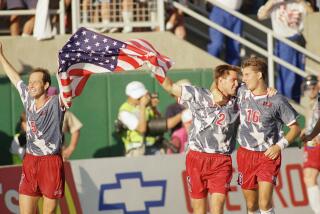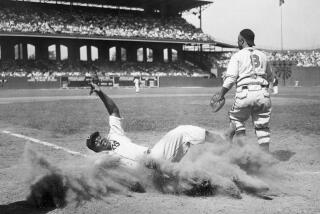Did a baseball team win the first U.S. pro soccer league title?
BASEBALL/SOCCER URBAN LEGEND: The first American professional soccer league championship was won by a moonlighting baseball team.
While individual players had been paid for games going as far back as 1892, it was not until the early 20th Century that there was the first attempt to form an actual professional football league.
The National Football League (not to be confused with the modern NFL) formed (and disbanded) in 1902. It would not be until the American Professional Football Assn. formed in 1920 (which changed its name to the NFL in 1922) that a truly organized professional football league existed in America.
In 1898, the first professional basketball league was formed. Dubbed the National Basketball League, it had six teams in Pennsylvania and New Jersey. It lasted until 1904, the same year that the first professional hockey league was formed on the border of the United States and Canada. The International Professional Hockey League lasted just three years, but it inspired amateur clubs in Canada to go pro, as well, and within a few years there were professional hockey leagues all across Canada.
I mention all of these leagues because of a fascinating aspect of professional sports history in the United States. Obviously, professional baseball predated all of these leagues (professional baseball was pretty much the first professional sports league in the world). However, so did professional soccer! The first professional soccer league (do note that the term “soccer” was not used in the U.S. at this point in time. It was called football instead, as it is still referred to as all over the world. I’ll use the terms interchangeably in the piece) formed in 1894.
I received a question about this league the other week. Reader Justine wrote in to ask “I was just reading a book about baseball history. Is it true that the first professional soccer championship was won by a moonlighting baseball team?” I’ll let you know, Justine (and the rest of you, as well, of course), as we examine the fascinating first (and last) season of the American League of Professional Football (ALPF).
A longstanding tradition in the world of professional sports has been the desire by the owners of sports arenas, stadiums and parks to get more out of their property. After all, if your stadium is sitting there empty, you’re still paying for the property while not making any money off of it. As I’ve written about in a past Sports Legends Revealed (which you can read here), it was this desire to find other revenue streams for their hockey arenas that led the owners of a group of Northewast arena owners to form first the Ice Capades and then later, the National Basketball Assn. This was the same logic employed by six owners from the National League of Professional Baseball Clubs (also known as the National League, which still exists today as one-half of Major League Baseball) when they decided to form a football league to keep their parks occupied after the baseball season.
The six clubs were the Brooklyn Bridegrooms, Baltimore Orioles, Boston Beaneaters, New York Giants, Philadelphia Phillies and Washington Senators. Four of these six teams still exist today in one form or another (the Bridegrooms are today’s Dodgers, the Beanaters are today’s Braves and the Giants and the Phillies still have their same name). The league was promoted in many ways as an extension of professional baseball. The six football teams were named the same as the baseball clubs.
The president of the new league was Arthur A. Irwin, the manager of the Phillies. The managers of the other clubs were all nominally named the coaches of their respective new teams. In addition, part of the promotion for this new league was that baseball players would be on the teams. That novelty, though, never really followed through. There might have been one or two baseball players on five of the six teams, but only the Phillies (presumably because their manager was the President of the football league) actually played a goodly amount of baseball players on their team (unsurprisingly, the Phillies finished next to last in the league). One of the players was Sam Thompson, who would go on to be elected to the Baseball Hall of Fame in 1974.
Most of the other teams consisted of British and Irish immigrants who were already playing in semi-pro football leagues. In the late 1890s, the idea of being a “professional” athlete was looked down in most athletic circles, and the same held for the American Football Assn. (the first attempt to have an organizing soccer body in the United States) who barred anyone who played for the ALPF to compete in any AFA-sanctioned events. The Baltimore Orioles (not connected to either the modern Baltimore Orioles or the Baltimore Orioles team that eventually became the New York Yankees) were the only team to actually hire a professional football coach, bringing in A.W. Stewart, who brought with him eight professional players from England (including four from Manchester City). Stewart also played goal for the Orioles. Unsurprisingly, the Orioles won all of their matches.
The league was intended to have ten games, but the league did not finish the full season due to a variety of factors (Baltimore was the champion by virtue of winning all of its games). U.S. Immigration officials were set to investigate Baltimore’s usage of foreign professionals but most importantly, attendance was terrible. The big problem was that the games were held on weekday afternoons, just like baseball games. The crowds who attended football games, though, tended to be working class folks who were working at those times.
The weekend games (when these men were off work) did well. The Orioles had up to 8,000 people at weekend games but their weekday games did not even draw 1,000. The argument from the owners was that they did not want to compete with college football on Saturdays, but I think the more likely answer is that they were just applying the same schedule they were used to with baseball.
In any event, the league folded after six of the ten planned games were played. The owners said that they would play again in 1895 but the league never materialized. There was talk that the National League was worried about rumors about another rival baseball league forming (which eventually did a few years later with the American League) and they did not want to divert their attention in case something like that took place. I cannot speak as to what the rumors were precisely at the time. I can believe that it played a role, though. Mostly, though, I think the poor attendance was the biggest issue.
As to Justine’s question, I do not think that it is fair to term the Baltimore Orioles football club as a group of “moonlighting baseball players,” so I am going to go with a....
STATUS: False.
Thanks to the absolutely brilliant soccer/football historian Steve Holroyd for his work on the ALPF.
Be sure to check out my Sports Urban Legends Revealed for more sports urban legends! I have archives of all the past urban legends featured on the site in the categories of: Baseball, Football, Basketball, Hockey, the Olympics and Soccer/Football! Also be sure to check out my Entertainment Urban Legends Revealed for urban legends about the worlds of TV, Movies, Music and more! Feel free (heck, I implore you!) to write in with your suggestions for future installments! My e-mail address is bcronin@legendsrevealed.com. And please buy my new book, “Why Does Batman Carry Shark Repellent?” here. It is due out May 29th! Also, you might like to purchase my first book, “Was Superman a Spy? And Other Comic Book Legends Revealed! here.
More to Read
Go beyond the scoreboard
Get the latest on L.A.'s teams in the daily Sports Report newsletter.
You may occasionally receive promotional content from the Los Angeles Times.










